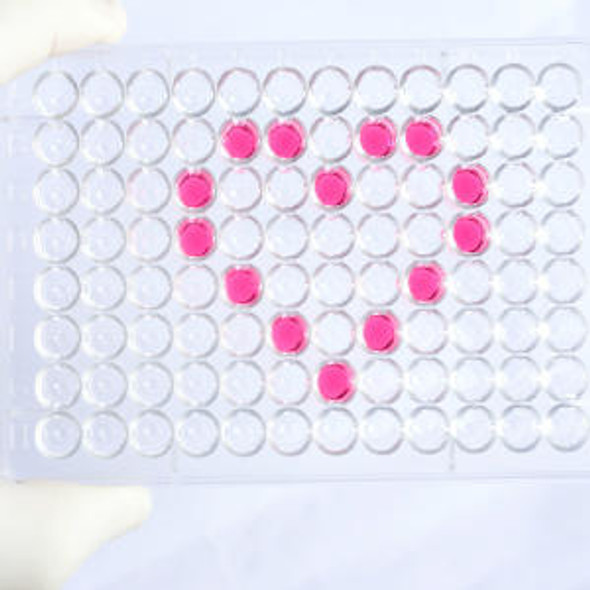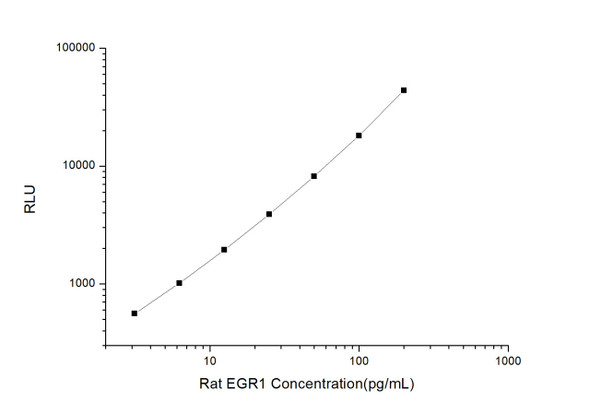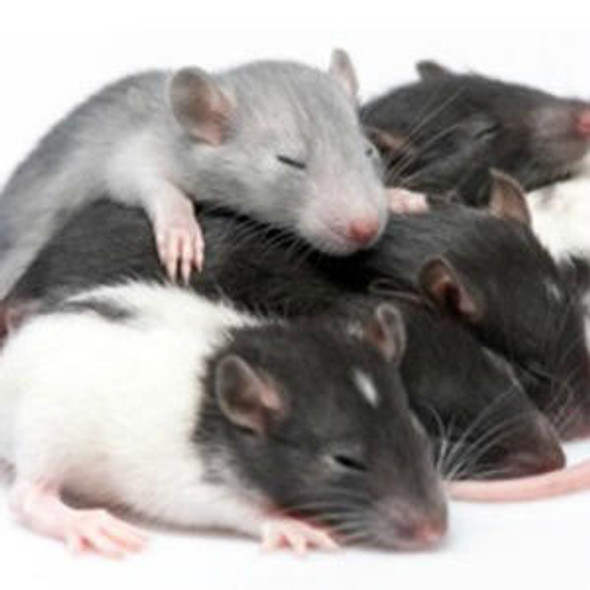Human Cell Biology ELISA Kits 5
Human EGR1 (Early Growth Response Protein 1) CLIA Kit (HUES01185)
- SKU:
- HUES01185
- Product Type:
- ELISA Kit
- ELISA Type:
- CLIA Kit
- Size:
- 96 Assays
- Sensitivity:
- 18.75pg/mL
- Range:
- 31.25-2000pg/mL
- ELISA Type:
- Sandwich
- Reactivity:
- Human
- Sample Type:
- Serum, plasma and other biological fluids
- Research Area:
- Cell Biology
Description
| Assay type: | Sandwich |
| Format: | 96T |
| Assay time: | 4.5h |
| Reactivity: | Human |
| Detection method: | Chemiluminescence |
| Detection range: | 31.25-2000 pg/mL |
| Sensitivity: | 18.75 pg/mL |
| Sample volume: | 100µL |
| Sample type: | Serum, plasma and other biological fluids |
| Repeatability: | CV < 15% |
| Specificity: | This kit recognizes Human EGR1 in samples. No significant cross-reactivity or interference between Human EGR1 and analogues was observed. |
This kit uses Sandwich-CLIA as the method. The micro CLIA plate provided in this kit has been pre-coated with an antibody specific to Human EGR1. Standards or samples are added to the appropriate micro CLIA plate wells and combined with the specific antibody. Then a biotinylated detection antibody specific for Human EGR1 and Avidin-Horseradish Peroxidase (HRP) conjugate are added to each micro plate well successively and incubated. Free components are washed away. The substrate solution is added to each well. Only those wells that contain Human EGR1, biotinylated detection antibody and Avidin-HRP conjugate will appear fluorescence. The Relative light unit (RLU) value is measured spectrophotometrically by the Chemiluminescence immunoassay analyzer. The RLU value is positively associated with the concentration of Human EGR1. The concentration of Human EGR1 in the samples can be calculated by comparing the RLU of the samples to the standard curve.
| UniProt Protein Function: | EGR1: Transcriptional regulator. Recognizes and binds to the DNA sequence 5'-CGCCCCCGC-3'(EGR-site). Activates the transcription of target genes whose products are required for mitogenesis and differentiation. By growth factors. Belongs to the EGR C2H2-type zinc-finger protein family. |
| UniProt Protein Details: | Protein type:DNA-binding; C2H2-type zinc finger protein; Transcription factor Chromosomal Location of Human Ortholog: 5q31. 1 Cellular Component: nucleoplasm; cytoplasm; nucleus Molecular Function:histone acetyltransferase binding; protein binding; DNA binding; sequence-specific DNA binding; metal ion binding; double-stranded DNA binding; transcription factor binding; transcription factor activity Biological Process: regulation of long-term neuronal synaptic plasticity; circadian rhythm; response to nutrient levels; transcription from RNA polymerase II promoter; cytokine and chemokine mediated signaling pathway; positive regulation of transcription, DNA-dependent; response to amphetamine; negative regulation of transcription from RNA polymerase II promoter; response to cocaine; BMP signaling pathway; response to ethanol; learning and/or memory; cellular response to insulin stimulus; positive regulation of neuron apoptosis; response to glucose stimulus; oligodendrocyte differentiation; positive regulation of transcription from RNA polymerase II promoter; response to electrical stimulus; T cell differentiation; regulation of protein sumoylation; negative regulation of apoptosis |
| NCBI Summary: | The protein encoded by this gene belongs to the EGR family of C2H2-type zinc-finger proteins. It is a nuclear protein and functions as a transcriptional regulator. The products of target genes it activates are required for differentitation and mitogenesis. Studies suggest this is a cancer suppressor gene. [provided by RefSeq, Dec 2014] |
| UniProt Code: | P18146 |
| NCBI GenInfo Identifier: | 119242 |
| NCBI Gene ID: | 1958 |
| NCBI Accession: | P18146. 1 |
| UniProt Related Accession: | P18146 |
| Molecular Weight: | 543 |
| NCBI Full Name: | Early growth response protein 1 |
| NCBI Synonym Full Names: | early growth response 1 |
| NCBI Official Symbol: | EGR1 |
| NCBI Official Synonym Symbols: | TIS8; AT225; G0S30; NGFI-A; ZNF225; KROX-24; ZIF-268 |
| NCBI Protein Information: | early growth response protein 1; EGR-1; zinc finger protein 225; transcription factor ETR103; transcription factor Zif268; zinc finger protein Krox-24; nerve growth factor-induced protein A |
| UniProt Protein Name: | Early growth response protein 1 |
| UniProt Synonym Protein Names: | AT225; Nerve growth factor-induced protein A; NGFI-A; Transcription factor ETR103; Transcription factor Zif268; Zinc finger protein 225; Zinc finger protein Krox-24 |
| Protein Family: | Early growth response protein |
| UniProt Gene Name: | EGR1 |
| UniProt Entry Name: | EGR1_HUMAN |
As the RLU values of the standard curve may vary according to the conditions of the actual assay performance (e. g. operator, pipetting technique, washing technique or temperature effects), the operator should establish a standard curve for each test. Typical standard curve and data is provided below for reference only.
| Concentration (pg/mL) | RLU | Average | Corrected |
| 2000 | 53420 58022 | 55721 | 55693 |
| 1000 | 23292 24656 | 23974 | 23946 |
| 500 | 11989 10075 | 11032 | 11004 |
| 250 | 4836 5752 | 5294 | 5266 |
| 125 | 2762 2454 | 2608 | 2580 |
| 62.5 | 1372 1250 | 1311 | 1283 |
| 31.25 | 628 720 | 674 | 646 |
| 0 | 27 29 | 28 | -- |
Precision
Intra-assay Precision (Precision within an assay): 3 samples with low, mid range and high level Human EGR1 were tested 20 times on one plate, respectively.
Inter-assay Precision (Precision between assays): 3 samples with low, mid range and high level Human EGR1 were tested on 3 different plates, 20 replicates in each plate.
| Intra-assay Precision | Inter-assay Precision | |||||
| Sample | 1 | 2 | 3 | 1 | 2 | 3 |
| n | 20 | 20 | 20 | 20 | 20 | 20 |
| Mean (pg/mL) | 94.01 | 174.56 | 894.64 | 85.87 | 171.39 | 905.98 |
| Standard deviation | 10.16 | 15.10 | 81.05 | 7.62 | 16.66 | 84.62 |
| C V (%) | 10.81 | 8.65 | 9.06 | 8.87 | 9.72 | 9.34 |
Recovery
The recovery of Human EGR1 spiked at three different levels in samples throughout the range of the assay was evaluated in various matrices.
| Sample Type | Range (%) | Average Recovery (%) |
| Serum (n=5) | 98-114 | 106 |
| EDTA plasma (n=5) | 89-102 | 94 |
| Cell culture media (n=5) | 86-99 | 93 |
Linearity
Samples were spiked with high concentrations of Human EGR1 and diluted with Reference Standard & Sample Diluent to produce samples with values within the range of the assay.
| Serum (n=5) | EDTA plasma (n=5) | Cell culture media (n=5) | ||
| 1:2 | Range (%) | 86-98 | 92-104 | 99-114 |
| Average (%) | 93 | 99 | 105 | |
| 1:4 | Range (%) | 95-107 | 88-98 | 97-114 |
| Average (%) | 102 | 93 | 105 | |
| 1:8 | Range (%) | 97-109 | 101-116 | 92-106 |
| Average (%) | 103 | 108 | 99 | |
| 1:16 | Range (%) | 97-112 | 101-114 | 97-112 |
| Average (%) | 102 | 107 | 103 |
An unopened kit can be stored at 4°C for 1 month. If the kit is not used within 1 month, store the items separately according to the following conditions once the kit is received.
| Item | Specifications | Storage |
| Micro CLIA Plate(Dismountable) | 8 wells ×12 strips | -20°C, 6 months |
| Reference Standard | 2 vials | |
| Concentrated Biotinylated Detection Ab (100×) | 1 vial, 120 µL | |
| Concentrated HRP Conjugate (100×) | 1 vial, 120 µL | -20°C(shading light), 6 months |
| Reference Standard & Sample Diluent | 1 vial, 20 mL | 4°C, 6 months |
| Biotinylated Detection Ab Diluent | 1 vial, 14 mL | |
| HRP Conjugate Diluent | 1 vial, 14 mL | |
| Concentrated Wash Buffer (25×) | 1 vial, 30 mL | |
| Substrate Reagent A | 1 vial, 5 mL | 4°C (shading light) |
| Substrate Reagent B | 1 vial, 5 mL | 4°C (shading light) |
| Plate Sealer | 5 pieces | |
| Product Description | 1 copy | |
| Certificate of Analysis | 1 copy |
- Set standard, test sample and control (zero) wells on the pre-coated plate and record theirpositions. It is recommended to measure each standard and sample in duplicate. Note: addall solutions to the bottom of the plate wells while avoiding contact with the well walls. Ensuresolutions do not foam when adding to the wells.
- Aliquot 100 µL of standard solutions into the standard wells.
- Add 100 µL of Sample / Standard dilution buffer into the control (zero) well.
- Add 100 µL of properly diluted sample (serum, plasma, tissue homogenates and otherbiological fluids. ) into test sample wells.
- Cover the plate with the sealer provided in the kit and incubate for 90 min at 37 °C.
- Aspirate the liquid from each well, do not wash. Immediately add 100 µL of BiotinylatedDetection Ab working solution to each well. Cover the plate with a plate seal and gently mix. Incubate for 1 hour at 37 °C.
- Aspirate or decant the solution from the plate and add 350 µL of wash buffer to each welland incubate for 1-2 minutes at room temperature. Aspirate the solution from each well andclap the plate on absorbent filter paper to dry. Repeat this process 3 times. Note: a microplatewasher can be used in this step and other wash steps.
- Add 100 µL of HRP Conjugate working solution to each well. Cover with a plate seal andincubate for 30 min at 37 °C.
- Aspirate or decant the solution from each well. Repeat the wash process for five times asconducted in step 7.
- Add 100 µL of Substrate mixture solution to each well. Cover with a new plate seal andincubate for no more than 5 min at 37 °C. Protect the plate from light.
- Determine the RLU value of each well immediately.






